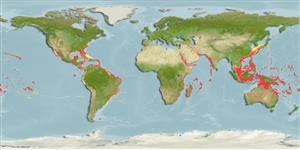Common names from other countries
Environment: milieu / climate zone / depth range / distribution range
Ecologia
; intervalo de profundidade 0 - 139 m (Ref. 81020). Tropical
Indo-Pacific and Western Central Atlantic.
Length at first maturity / Tamanho / Peso / Idade
Maturity: Lm ? range ? - ? cm Max length : 8.0 cm WD macho/indeterminado; (Ref. 800)
Found subtidally (Ref. 102838). Inhabits hard substrates by boring on rocks in shallow waters (Ref. 800). It is also found on fore-reefs (Ref. 87903). A grazing echinoid, predominantly scraping the substratum of turf algae (Ref. 125618). Feeds on algae (Also Ref. 129602) and small invertebrates. Associated with Athanas indica, which hides between its spines (Ref. 800). Associated with coral communities. Burrowing species (Ref. 129602).
Life cycle and mating behavior
Maturidade | Reprodução | Desova | Ovos | Fecundidade | Larvas
Members of the class Echinoidea are gonochoric. Fertilization is external. Brooding is common, eggs are held either on the peristome, around the periproct or deep into the concavities on the petaloids. Life cycle: Embryos develop into planktotrophic larvae (echinoplateus) and live for several months before they sink to the bottom using their tube feet to adhere on the ground where they metamorphose into young urchins.
Schoppe, S. 2000. (Ref. 800)
Categoria na Lista Vermelha da IUCN (Ref. 130435)
Categoria CITES (Ref. 108899)
Not Evaluated
Not Evaluated
Utilização humana
| FishSource |
Ferramentas
Fontes da internet
Estimates based on models
Preferred temperature
(Ref.
115969): 23.3 - 28.8, mean 27.1 (based on 1386 cells).
Resiliência
Elevada, tempo mínimo de duplicação da população menor que 15 meses (K=0.4).
Vulnerabilidade
Low vulnerability (10 of 100).
Categoria de preço
Unknown.
